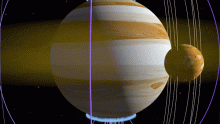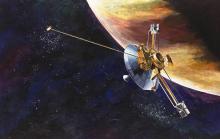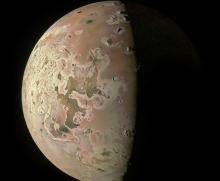Listen to today's episode of StarDate on the web the same day it airs in high-quality streaming audio without any extra ads or announcements. Choose a $8 one-month pass, or listen every day for a year for just $30.
You are here
Moon and Planets
The giants of the solar system will flank the gibbous Moon at dawn tomorrow. Jupiter — the king of the planets — will stand to the right of the Moon, with fainter Saturn the same distance to the left of the Moon.
After the Sun, Jupiter and Saturn make up most of the mass of the solar system. By comparison, all the other planets, moons, and smaller bodies are little more than the crumbs on the table after a big dinner.
The two planets grew so big in part because they were beyond the “snow line.” That was the distance from the embryonic Sun where temperatures were cold enough for water and other compounds to form solid grains. Those particles could stick together to form bigger and bigger bodies — helping Jupiter and Saturn form giant cores. The cores then pulled in huge amounts of hydrogen and helium gas that surrounded the Sun, boosting both worlds to immense proportions.
Planets that were inside the snow line couldn’t grow nearly as big. The Sun’s heat kept many compounds from forming solid particles. And solar radiation blew planet-making materials away from the inner solar system, toward the realm where Jupiter and Saturn were born. That left a thinner supply of planet-making materials, so the planets were thinner, too.
So Earth and the other three inner planets are small and dense — made of materials that the young Sun couldn’t easily vanquish.
We’ll have more about the Moon and Saturn tomorrow.
Script by Damond Benningfield






